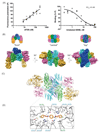Binding of ISRIB reveals a regulatory site in the nucleotide exchange factor eIF2B
- PMID: 29599245
- PMCID: PMC5889100
- DOI: 10.1126/science.aar5129
Binding of ISRIB reveals a regulatory site in the nucleotide exchange factor eIF2B
Abstract
The integrated stress response (ISR) is a conserved translational and transcriptional program affecting metabolism, memory, and immunity. The ISR is mediated by stress-induced phosphorylation of eukaryotic translation initiation factor 2α (eIF2α) that attenuates the guanine nucleotide exchange factor eIF2B. A chemical inhibitor of the ISR, ISRIB, reverses the attenuation of eIF2B by phosphorylated eIF2α, protecting mice from neurodegeneration and traumatic brain injury. We describe a 4.1-angstrom-resolution cryo-electron microscopy structure of human eIF2B with an ISRIB molecule bound at the interface between the β and δ regulatory subunits. Mutagenesis of residues lining this pocket altered the hierarchical cellular response to ISRIB analogs in vivo and ISRIB binding in vitro. Our findings point to a site in eIF2B that can be exploited by ISRIB to regulate translation.
Copyright © 2018 The Authors, some rights reserved; exclusive licensee American Association for the Advancement of Science. No claim to original U.S. Government Works.
Conflict of interest statement
Figures



Similar articles
-
ISRIB Blunts the Integrated Stress Response by Allosterically Antagonising the Inhibitory Effect of Phosphorylated eIF2 on eIF2B.Mol Cell. 2021 Jan 7;81(1):88-103.e6. doi: 10.1016/j.molcel.2020.10.031. Epub 2020 Nov 20. Mol Cell. 2021. PMID: 33220178 Free PMC article.
-
Structure of the nucleotide exchange factor eIF2B reveals mechanism of memory-enhancing molecule.Science. 2018 Mar 30;359(6383):eaaq0939. doi: 10.1126/science.aaq0939. Science. 2018. PMID: 29599213 Free PMC article.
-
Pharmacological dimerization and activation of the exchange factor eIF2B antagonizes the integrated stress response.Elife. 2015 Apr 15;4:e07314. doi: 10.7554/eLife.07314. Elife. 2015. PMID: 25875391 Free PMC article.
-
Structural insights into ISRIB, a memory-enhancing inhibitor of the integrated stress response.FEBS J. 2020 Jan;287(2):239-245. doi: 10.1111/febs.15073. Epub 2019 Nov 7. FEBS J. 2020. PMID: 31550413 Review.
-
eIF2B: recent structural and functional insights into a key regulator of translation.Biochem Soc Trans. 2015 Dec;43(6):1234-40. doi: 10.1042/BST20150164. Biochem Soc Trans. 2015. PMID: 26614666 Review.
Cited by
-
ISRIB facilitates the co-culture of human trophoblast stem cells and embryonic stem cells.Cell Prolif. 2024 Jun;57(6):e13599. doi: 10.1111/cpr.13599. Epub 2024 Jan 12. Cell Prolif. 2024. PMID: 38217296 Free PMC article.
-
Small molecule strategies to harness the unfolded protein response: where do we go from here?J Biol Chem. 2020 Nov 13;295(46):15692-15711. doi: 10.1074/jbc.REV120.010218. Epub 2020 Sep 4. J Biol Chem. 2020. PMID: 32887796 Free PMC article. Review.
-
Highly specific σ2R/TMEM97 ligand FEM-1689 alleviates neuropathic pain and inhibits the integrated stress response.Proc Natl Acad Sci U S A. 2023 Dec 26;120(52):e2306090120. doi: 10.1073/pnas.2306090120. Epub 2023 Dec 20. Proc Natl Acad Sci U S A. 2023. PMID: 38117854 Free PMC article.
-
eIF2B activator prevents neurological defects caused by a chronic integrated stress response.Elife. 2019 Jan 9;8:e42940. doi: 10.7554/eLife.42940. Elife. 2019. PMID: 30624206 Free PMC article.
-
The Common Cellular Events in the Neurodegenerative Diseases and the Associated Role of Endoplasmic Reticulum Stress.Int J Mol Sci. 2022 May 24;23(11):5894. doi: 10.3390/ijms23115894. Int J Mol Sci. 2022. PMID: 35682574 Free PMC article. Review.
References
-
- Panniers R, Henshaw EC. A GDP/GTP exchange factor essential for eukaryotic initiation factor 2 cycling in Ehrlich ascites tumor cells and its regulation by eukaryotic initiation factor 2 phosphorylation. J Biol Chem. 1983;258:7928–7934. - PubMed
Publication types
MeSH terms
Substances
Grants and funding
LinkOut - more resources
Full Text Sources
Other Literature Sources
Molecular Biology Databases
Research Materials

